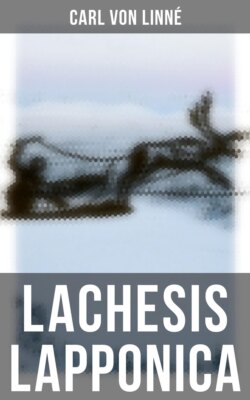Читать книгу Lachesis Lapponica - Carl von Linné - Страница 12
На сайте Литреса книга снята с продажи.
May 20.
ОглавлениеIn some places the cows were without horns; a mere variety of the common kind, and not a distinct species. Nor have they been originally formed thus; for though in them the most essential character of their genus is, as to external appearance, wanting, still rudiments of horns are to be found under the skin. A contrary variety is observable, in Scania and other places, in the ram, which has sometimes four, six or eight horns, that part growing luxuriant to excess, like double flowers.
The forests chiefly consist of the Hoary-leaved Alder. Birch trees here also bear abundance of matted branches. To whatever side I cast my eyes, nothing but lofty mountains were to be seen. Not far from Æssja the little Strawberry-leaved Bramble (Rubus arcticus) was in full bloom. The cold weather, however, had rendered the purple of its blossoms paler than usual. I cannot help thinking that it might more properly and specifically be called Rubus humilis, folio fragariæ, flore rubro, than fructu rubro. It likewise seems to me, that this plant exactly agrees in structure with the Rubus folio ribes alpinus anglicus of authors, which I must compare with it the first opportunity13.
A quarter of a mile further is Doggsta, on the other side of which, close to the road, stands a tremendously steep and lofty mountain, called Skulaberget, (the mountain of Skula,14) in which I was informed there was a remarkable cavern. This I wished to explore, but the people told me it was impossible. With much difficulty I prevailed on two men to show me the way. We climbed the rocks, creeping on our hands and knees, and often slipping back again; we had no sooner advanced a little, than all our labour was lost by a retrograde motion. Sometimes we caught hold of bushes, sometimes of small projecting stones. Had they failed us, which was very likely to have been the case, our lives might have paid for it. I was following one of the men in climbing a steep rock; but seeing the other had better success, I endeavoured to overtake him. I had but just left my former situation, when a large mass of rock broke loose from a spot which my late guide had just passed, and fell exactly where I had been, with such force that it struck fire as it went. If I had not providentially changed my route, nobody would ever have heard of me more. Shortly afterwards another fragment came tumbling down. I am not sure that the man did not roll it down on purpose. At length, quite spent with toil, we reached the object of our pursuit, which is a cavity in the middle of the mountain. I expected to have seen something to repay my curiosity, but found a mere cavern, formed like a circle or arch, fourteen Parisian feet high, eighteen broad, and twenty-two long. The stones that compose it are of a very hard kind of quartz or spar, yet the sides of the cavern are in many places as even as if they had been cut artificially. Several different strata are distinguishable, particularly in the roof, which is concave like an arch. In that part a hole appears, intended, as I was told, for a chimney. Whether it is pervious to any extent, I know not. Some convulsion of the mountain seems to have shivered the rock in longitudinal fissures. All the shivers of stone, many of which lie on the floor, are quadrangular, and of a considerable size. I am fully persuaded of this grotto having been formed by the hand of Nature, and that art had afterwards merely cleared away the fragments of stone. The entrance is sufficiently large to afford a full view of the inside, occupying an eighth part of the whole. Drops of water trickle down from the roof near one of the sides. Some species of Polypodium, the Asplenium Trichomanes, and other ferns, grow on the adjacent parts of the mountain. Before the orifice of this cavern grew a Sallow tree, which when king Charles XI. passed this way was cut down, and, having grown up again, was a second time felled by the inhabitants15.
Having taken leave of this mountain, I had scarcely continued my journey a quarter of a mile before I found a great part of the country covered with snow, in patches some inches deep. The pretty spring flowers had gradually disappeared. The buds of the birch, which so greatly contribute to the beauty of the forests, were not yet put forth. I saw nothing but wintry plants, the heath and the whortle-berry, peeping through the snow. The high mountains which surround this tract, and screen it from the genial southern and western breezes, added to the thick forests which will hardly allow the first mild showers of spring to reach the ground, may account for the long duration of the snow.
This part of the country is very mountainous, and is watered by many small rills, originating on the sides of the mountains from the copious rains falling upon them, and running from thence, by various channels, to swell the streams of Helsingland and Medelpad.
The cornfields afford a crop two years successively, and lie fallow the third. Rye is seldom or never sown here, being too slow in coming to perfection, so that the land, which must next receive the Barley, would be too much exhausted. The ploughs are made with two transverse beams on one side, that the sods may be turned the first time the land is ploughed, as will presently be more particularly explained.
